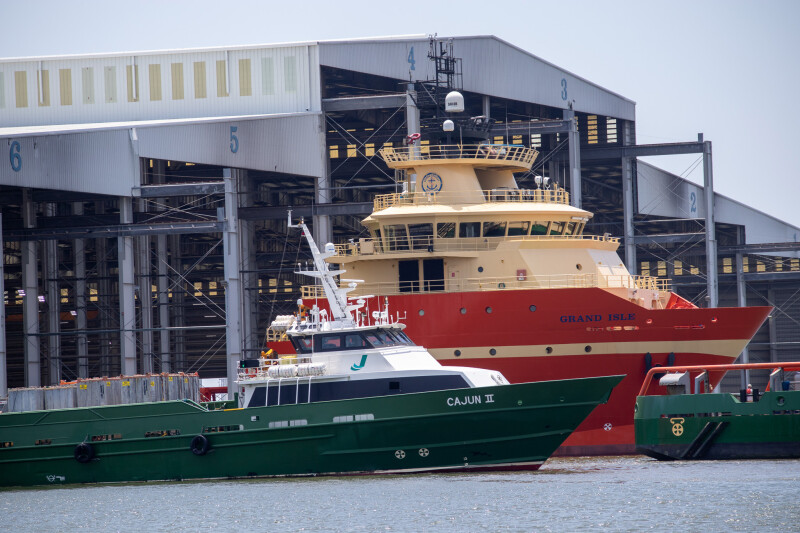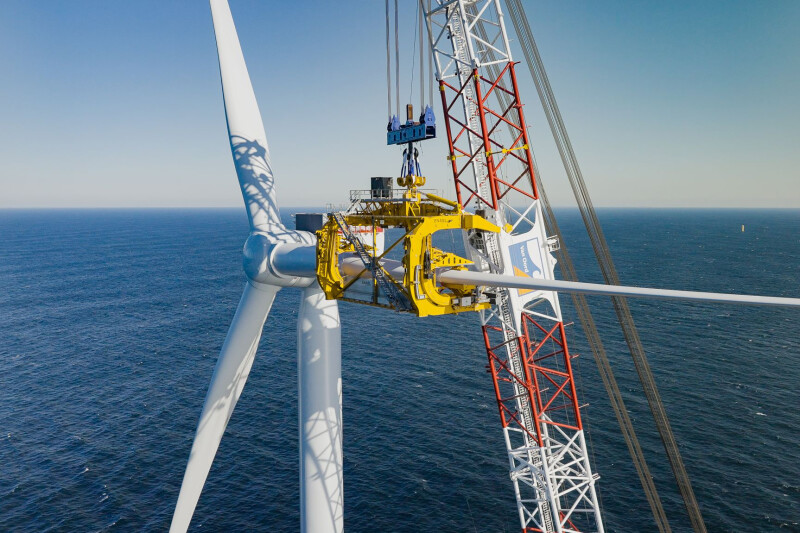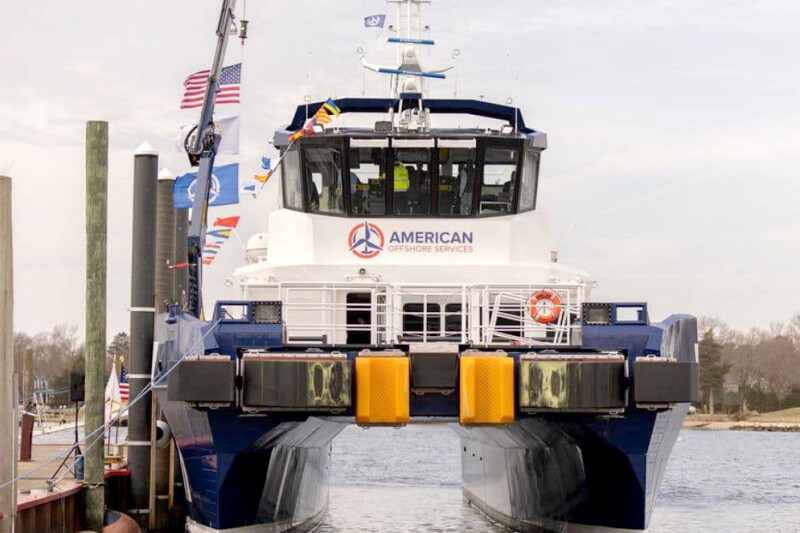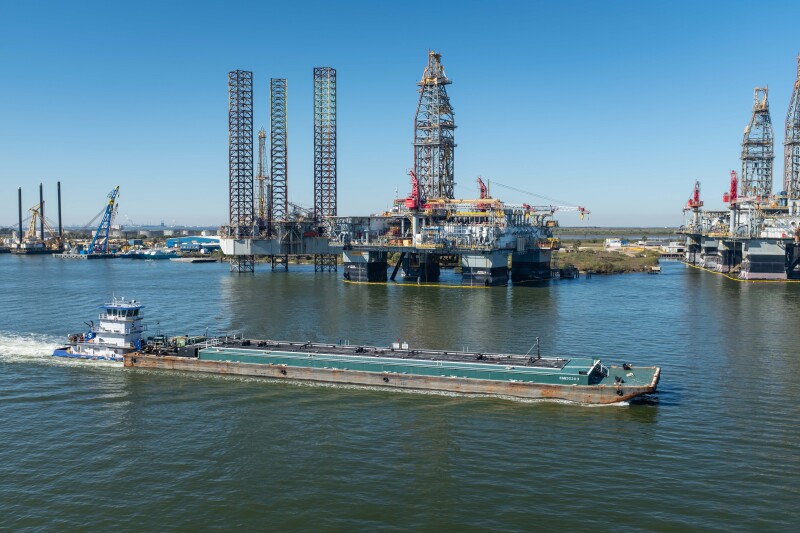President Joe Biden wants the U.S. offshore wind industry to be producing 30 gigawatts of electrical power by 2030 — enough, the administration says, to power 10 million homes. That would be the equivalent of about 16,920 bbls. of petroleum per hour or 384,000 bbls. of oil per day.
By comparison, the Energy Information Administration (EIA) says the U.S. consumes approximately 20 million bbls. of petroleum, including oil and natural gas, per day.
Indeed, according to 2023 EIA statistics, if every bit of the residential electricity in this country were produced by wind power, it would be less than enough to meet half of U.S. home energy needs. Nearly all of the crude oil that is produced in or imported into the U.S. is refined into petroleum products, such as gasoline, diesel fuel, heating oil, and jet fuel. Liquids produced from natural gas processing are also consumed as petroleum products, according to the EIA.
So far, there are no plans to import wind energy into the U.S., even if that were possible. Consequently, offshore wind will not unseat oil and gas production as the prime source of energy production in the U.S. anytime soon, certainly not by 2030. In fact, big oil is pulling back on some of its offshore wind involvement. According to Reuters, Shell pulled out of a South Korean floating offshore wind project in February to concentrate on more profitable ventures.
Last summer, Shell’s CEO Wael Sawan told the BBC, “The reality is the energy system of today continues to desperately need oil and gas,” he said. “I think what would be dangerous and irresponsible [would be] to actually cut out oil and gas production so that the cost of living — as we saw just last year — starts to shoot up again.”
BP, meanwhile, had aimed to reduce emissions by 35% to 40% by the end of the decade, but in March 2023 scaled back the declaration to a 20% to 30% reduction target. Both oil giants have stated the transition to renewable energy must be a more gradual process with oil and gas carrying the load for now.
LEASE SALES
The Bureau of Ocean Energy Management (BOEM) in January released final revisions to its bid adequacy procedures.
The updated rules are designed to ensure that U.S. taxpayers receive fair market value from Outer Continental Shelf (OCS) oil and gas lease sales. BOEM intends to begin using the revised procedures to evaluate lease sale bids received as part of the 2024-2029 National OCS Oil and Gas Leasing Program.
The revisions include the following:
- Update BOEM’s methodology for measuring the adequacy of bids for OCS oil and gas lease sales to enhance clarity and transparency.
- Discontinue the use of tract classification, which has had minimal impact on the procedural analysis of fair market value.
- Include other, minor changes to clarify and streamline processes.
BOEM published its proposed revisions in the Federal Register and received over 15,500 public comments. The final Gulf of Mexico Oil and Gas Lease Sale — 261 — not subject to the new revisions was held in late December 2023. The sale generated over $382 million in high bids for 311 tracts covering 1.7 million acres in federal waters of the Gulf of Mexico. A total of 26 companies participated in the lease sale, submitting 352 bids totaling about $442 million.
Under a ruling from the U.S. Court of Appeals for the Fifth Circuit in New Orleans, BOEM included lease blocks that were previously excluded due to potential impacts to the Rice’s whale population from oil and gas activities in the Gulf of Mexico.

Revenues received from offshore oil and gas leases (including high bids, rental payments, and royalty payments) are directed to the U.S. Treasury, certain Gulf Coast states (Texas, Louisiana, Mississippi, and Alabama) and local governments, the Land and Water Conservation Fund, and the Historic Preservation Fund.
Lease Sale 261 offered 13,482 unleased blocks on 72.7 million acres in the Gulf’s Western, Central and Eastern Planning Areas. The $382 million is a substantial increase over the $264 million in high bids for 313 tracts covering 1.6 million acres in federal waters of the Gulf in March 2023.
LEGAL COMPLICATIONS
As far as offshore oil and gas production is concerned, getting the energy from out there to in here is not only expensive but also subject to state, federal, and maritime law.
“Maritime law applies to vessels, maritime commerce, and maritime personnel. However, what a ‘vessel’ is and who a ‘seaman’ is in the offshore energy context is not readily apparent,” said Grady Hurley, a partner in and co-leader of the maritime litigation, arbitration, and dispute resolution team and co-chair of the energy, environmental and natural resources industry team for New Orleans law firm Jones Walker Ltd. “Although 1 USC 3 describes everything that floats as a vessel, floating platforms such as spars, tension-leg platforms [TLPs], and floating production units that are fixed and anchored to the seabed for extended periods are not considered vessels engaged in maritime commerce and thus subject to OCSLA (Outer Continental Shelf Land Act) for determining rights and remedies.”
Hurley said OCSLA applies federal law, which may be supplemented by the law of the adjacent state when there are legal inconsistencies. Maritime law applies to liftboats, jack-up rigs, and various offshore service vessels engaged in maritime commerce. “In the offshore context, not everything that floats is a vessel, and not every offshore worker on a vessel is a seaman.”
Offshore operations can be legally complex. Hurley cited the case of Earnest v. Palfinger Marine USA. “In Palfinger, the simple question was whether a contract to inspect and repair lifeboats affixed to a TLP located on the OCS was a maritime contract. Factually, after the lifeboats were inspected and repaired by Palfinger Marine on a Shell TLP, a corroded lifting cable failed during a drill, causing a lifeboat to fall from the platform and cause injury and death,” he said. “Contractual indemnities and choice-of-law provisions in the master service contract would be void if state law applied and enforceable if maritime law applied.”
Turns out the Fifth Circuit ruled the TLP was not a vessel and the platform lifeboats were vessels and “that OCSLA provided federal question jurisdiction; and that…the focus of the repair and maintenance contract involving a lifeboat, whether affixed or not, was maritime even if the lifeboat was not engaged in maritime commerce,” said Hurley.
Developers regroup after 2023 setbacks
By Kirk Moore, Contributing Editor

South Fork Wind, an array of 12 turbines 35 miles east of Montauk, N.Y., became the first fully operational offshore wind energy project in U.S. federal waters March 14 — a milestone for the fledging U.S. industry after months of developers' backing out of other once-heralded projects.
With a maximum nameplate rating of 132 megawatts, South Fork Wind by partners Ørsted and Eversource is from the early generation of U.S. offshore wind planning.
It was first approved by New York’s Long Island Power Authority in 2017 and is much smaller than the 806 MW Vineyard Wind project under construction off Massachusetts. That flagship project for New England powered up the first five turbines in February.
Despite weather delays, progress on Vineyard Wind continued apace in spring 2024, with up to 26 vessels active in the area, including crew transfer and installation vessels, fishing boats chartered as safety vessels, and tugs, according to daily updates from Vineyard Wind officials.
New York Gov. Kathy Hochul hailed the South Fork news: “With more projects in the pipeline, this is just the beginning of New York’s offshore wind future, and I look forward to continued partnership with the Biden Administration and local leaders to build a clean and resilient energy grid.”
That official expression of enthusiasm was understandable. South Fork’s startup came five months after New York officials in October agreed to adjust previous power purchase agreements for the Beacon Wind and Empire Wind projects.
New York’s decision came after moves in August by Avangrid, Shell New Energies, and Ocean Winds North America to pay termination fees and abandon earlier power purchase agreements with Connecticut and Massachusetts for their plans in southern New England waters.
Besieged by inflation, escalating equipment and supply chain problems, the developers insisted the earlier rate structures were simply not viable any longer.
With their ambitions for offshore wind power apparently at dire risk, the governors of six Northeast states — Massachusetts, Rhode Island, Connecticut, New York, New Jersey, and Maryland — appealed to the Biden administration. They warned the halcyon days of offshore wind optimism were closing.
“Instead of continued price declines, offshore wind faces cost increases in orders of a magnitude that threaten states’ ability to make purchasing decisions,” the governors warned in a Sept. 13 letter to President Biden. “These pressures are affecting not only procurements of new offshore wind but, critically, previously procured projects already in the pipeline.
“Absent intervention, these near-term projects are increasingly at risk of failing. Without federal action, offshore wind deployment in the U.S. is at serious risk of stalling because states’ ratepayers may be unable to absorb these significant new costs alone.”
The biggest shock came on Halloween when Ørsted abruptly announced it was dropping its Ocean Wind 1 and 2 projects planned off New Jersey.
A month later, at the International WorkBoat Show, Gulf of Mexico offshore operators who work in offshore wind said they anticipated a slowing, but not a stopping, of the U.S. market.
“I think the industry at least from the perspective of the U.S., is going to take a year off,” said Carl Annessa, executive vice president of Hornbeck Offshore Services Inc.
HOPE IN 2024
By spring 2024, offshore wind advocates could find some hope in green shoots. In late February, New York conditionally awarded two offshore wind projects in its fourth offshore wind solicitation, offering better power purchase prices for the 810-megawatt Empire Wind 1 project by Equinor and the 924 MW Sunrise Wind project by partners Ørsted and Eversource.
Avangrid Inc. received federal approval for the New England Wind project on April 2. The record of the decision from the Bureau of Ocean Energy Management opened the path for approving a construction and operations plan in July 2024 for the two-phase, 2-GW project bordering the Vineyard Wind lease.
“With this federal approval, New England Wind stands apart as the most advanced and shovel-ready offshore wind opportunity in the Northeast region,” said Avangrid CEO Pedro Azagra.

Despite the industry uncertainty of 2023, boatbuilders kept busy building the new U.S. support fleet. American Offshore Services (A-O-S), Blount Boats, Warren, R.I., Ørsted, and Eversource launched the 101' Gripper, a crew transfer vessel (CTV), the first crew transfer vessel built to service Ørsted and Eversource’s 704-megawatt Revolution Wind project, along with the South Fork and Sunrise Wind projects.
The new boat is one of five new CTVs that have been completed or are currently being built in Rhode Island for Ørsted and Eversource, and the first of two that will be owned and operated by A-O-S and built at Blount. Gripper is owned and operated by A-O-S in a partnership between Swedish CTV operator Northern Offshore Group and the U.S.-based investment firm OIC. A-O-S is basing its U.S. operations out of the Cambridge Innovation Center in downtown Providence, R.I.
As BOEM and wind developers try to advance, offshore wind critics sharpen their attacks. South Fork Wind was one of the earliest and most bitterly fought projects and continues to generate intense controversy in southern New England.
The Rhode Island Coastal Resources Management Council said, “The location of the SFW project on Cox’s Ledge, an area known for its biological diversity, is in our view one of the worst possible locations for this project.” The Bureau of Ocean Energy Management (BOEM) and South Fork developers settled on a later plan, reducing the number of turbines to 12 and shifting locations to avoid what were thought to be the most critical bottom habitat areas for fish.
The Rhode Island-based group Green Oceans assembled a coalition of fishermen and other coastal residents to file a new federal lawsuit in January challenging BOEM’s wind energy approvals as violating a wide range of federal laws.
“The government already admits they will have adverse impacts on the health of our fisheries, navigation safety, historic resources, endangered species, and environmental justice populations,” said Elizabeth Quattrocki Knight, co-founder and president of Green Oceans, when South Fork was switched on. “Yet, not a single academic study of real-world data has ever proven any benefits to climate change,” she said.
While Ørsted’s Ocean Wind projects are gone from the New Jersey scene, the Atlantic Shores project pushes on. The joint venture of Shell New Energies US LLC and EDF Renewables North America would be rated for 1,510 MW and take the forefront of New Jersey’s renewable energy ambitions.
It would also be highly visible from shore — within 8.4 miles of Long Beach Island resorts. The local opposition group Save Long Beach Island calls the planned array within sight “the closest-to-shore large turbine wind project in the world.”
On the West Coast, BOEM finalized wind energy areas off Oregon, and visual impacts are being protested by Confederated Tribes of the Coos, Lower Umpqua, and Siuslaw Indians.
“We believe it is our inherent right to have the ability to see across our viewsheds, as this direct connection is integral to our cultural practices and traditional way of life,” said Tribal Chief Doug Barrett.




